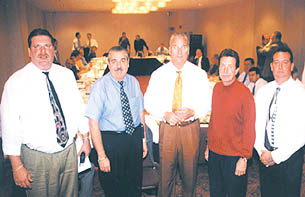Reorganized, re-energized Painters meet in Michigan
Date Posted: October 13 2000
The International Union of Painters and Allied Trades is restoring the roar in Michigan and around the nation.
Under new General President Michael E. Monroe, the union has been completely reorganized and is changing the way it does business in terms of union operations, training, political action and organizing.
Michigan's Painters District Council No. 22 was among the first councils to see the new structure in action, hosting the first of what will be an annual Central Regional Conference Sept. 29-Oct. 1 at Detroit's Renaissance Center. Monroe and other top International Union representatives as well as local union leaders were on hand to discuss strategy and set a course for the future.
"Our union has undergone a complete restructuring," Monroe said. "There are now four regions, and these conferences have been set up so that we can network and promulgate the efforts of the International Union on the local level."
The Painters have adopted the motto of "One Union," intended to unify the mission of union leaders and bring together the varied worker crafts represented by the International Union. The Painters also represent drywall finishers, glassworkers, sign display workers, paperhangers, water blasters, and scenic artists, among many others.
The union changed its name, replacing "brotherhood" with "union" for obvious gender-related reasons. The union has even changed its logo, re-using and re-designing the use of a lion in the old logo to play up the fighting spirit of a battling lion.
Until the Nov. 7 general election, Monroe said, the International Union's major battle will be in the area of political action. The Painters have committed $4 million nationwide - $100,000 of it in Michigan - on political spending to see to it that members' interests are represented.
"We've never been involved in this level of political activity," said James Williams, the IUPAT's general secretary-treasurer and Monroe's point man on political action. "We've put together a blueprint that starts at the top - we need to get Al Gore elected president. But we're also working on targeted campaigns across the country. We have four additional vice presidents working to shepherd the political action plan, we're paying the wages of 430 people full-time around the country to be available 24 hours until election day, we've set up phone banks, and printed thousands of signs.
"Prior to the campaign we attended hundreds of union meetings and members clearly stated that they wanted us to get involved in politics. Well, we're involved."
Monroe has initiated a new level of activism into the 130,000-member union. The Painters have been one of the most successful unions when it comes to organizing. While the entire AFL-CIO saw only a slight overall increase in membership from 1998-1999, the Painters' U.S. membership increased by 6 percent - the second-largest percentage gain of any union.
In 1999, IUPAT General Convention delegates confirmed their union's commitment to organizing by designating the general president as director of organizing. A major figure in the International Union's blueprint to keep the organizing successes going is new General Organizer B.J. Cardwell, a Michigan man out of Local 514 who was appointed to that position earlier this year by Monroe.
"I'm all over the place," Cardwell said. "Wherever locals need help organizing, I'm there."
Cardwell's old boss, Painters District Council No. 22 Secretary-Treasurer Bob Kennedy, said he enjoyed playing host. "It has been an honor and a pleasure to have the international representatives come to town for this first conference."
Monroe said it was appropriate to have the first Central Regional Conference in Michigan - "to showcase the City of Detroit and the ongoing building boom."

PARTICIPATING IN THE FIRST Painters Central Regional Conference are (l-r) International Union Vice President-at-Large Ray Price, IU General Vice President Ray Rapp, IU General President Michael E. Monroe, Michigan Painters District Council 22 Secretary-Treasurer Robert Kennedy, and IU General Organizer B.J. Cardwell.
